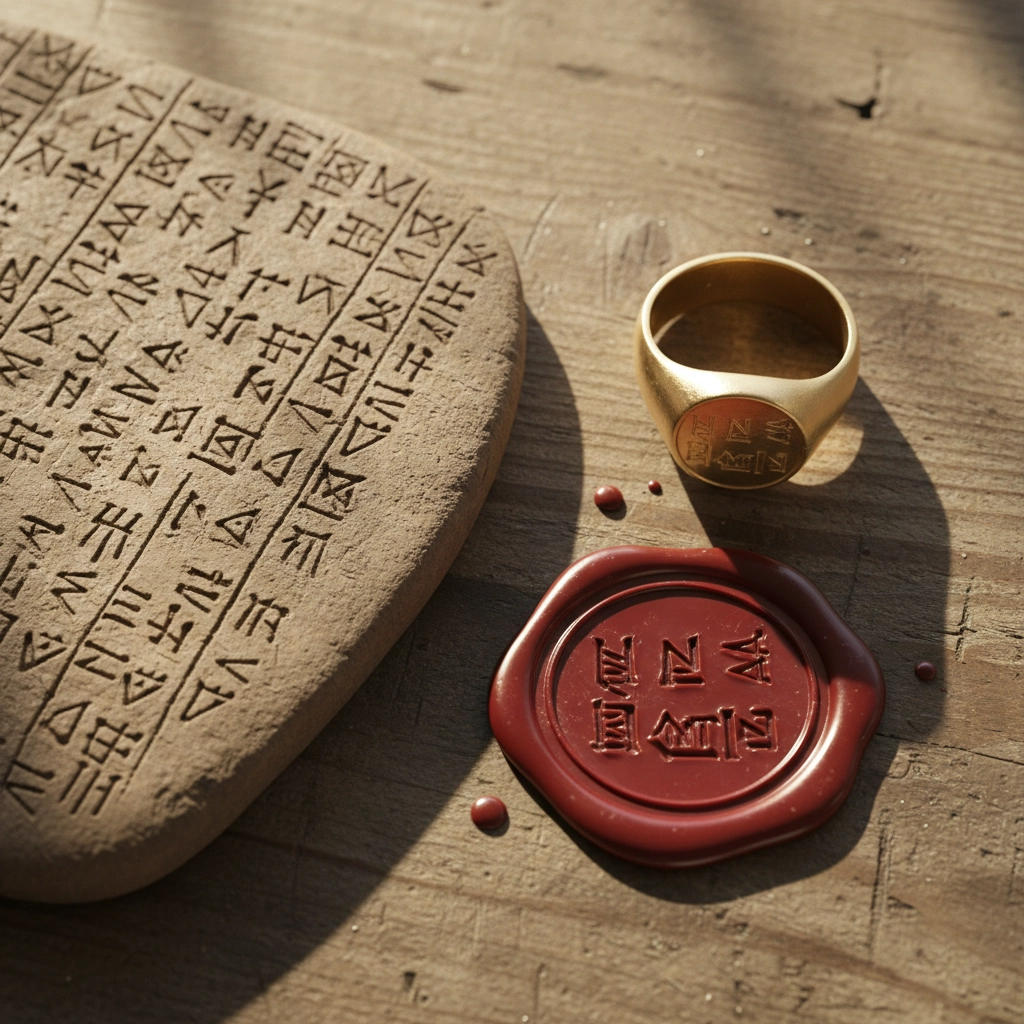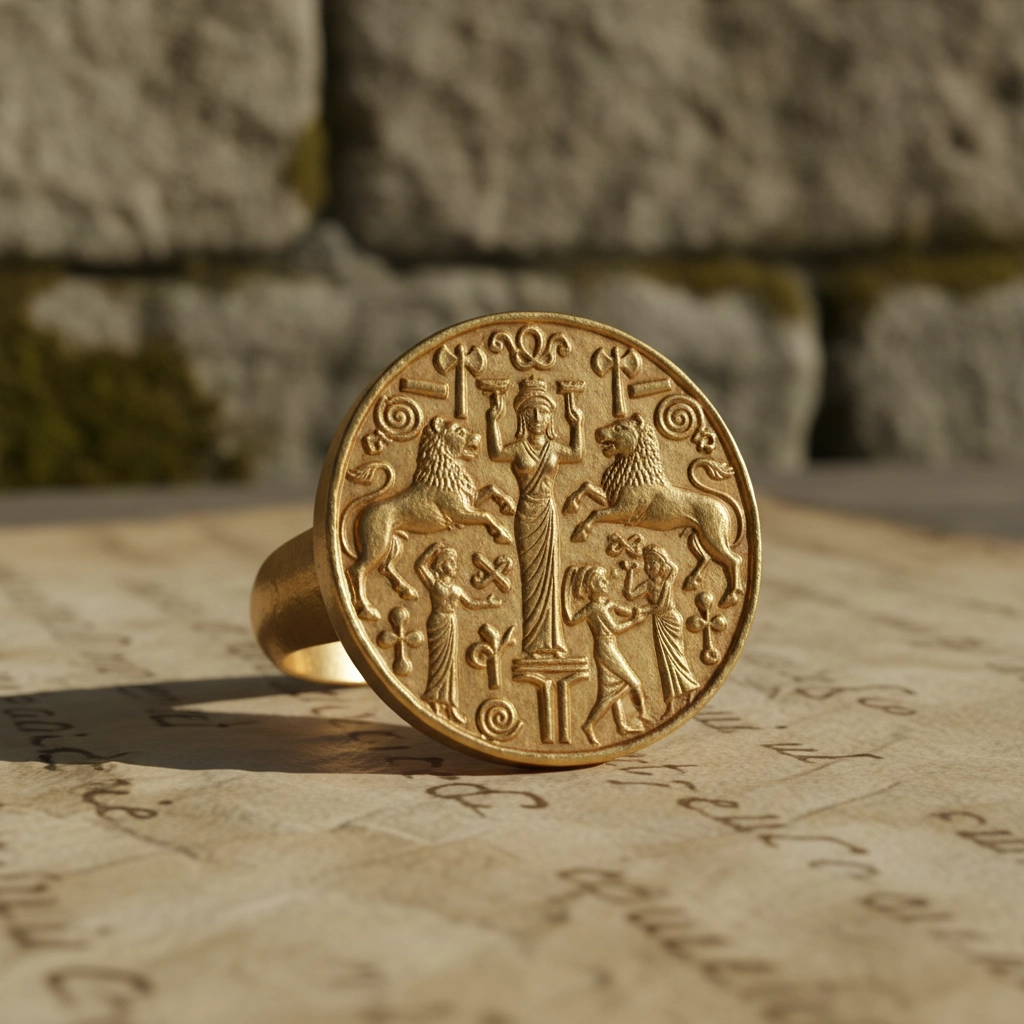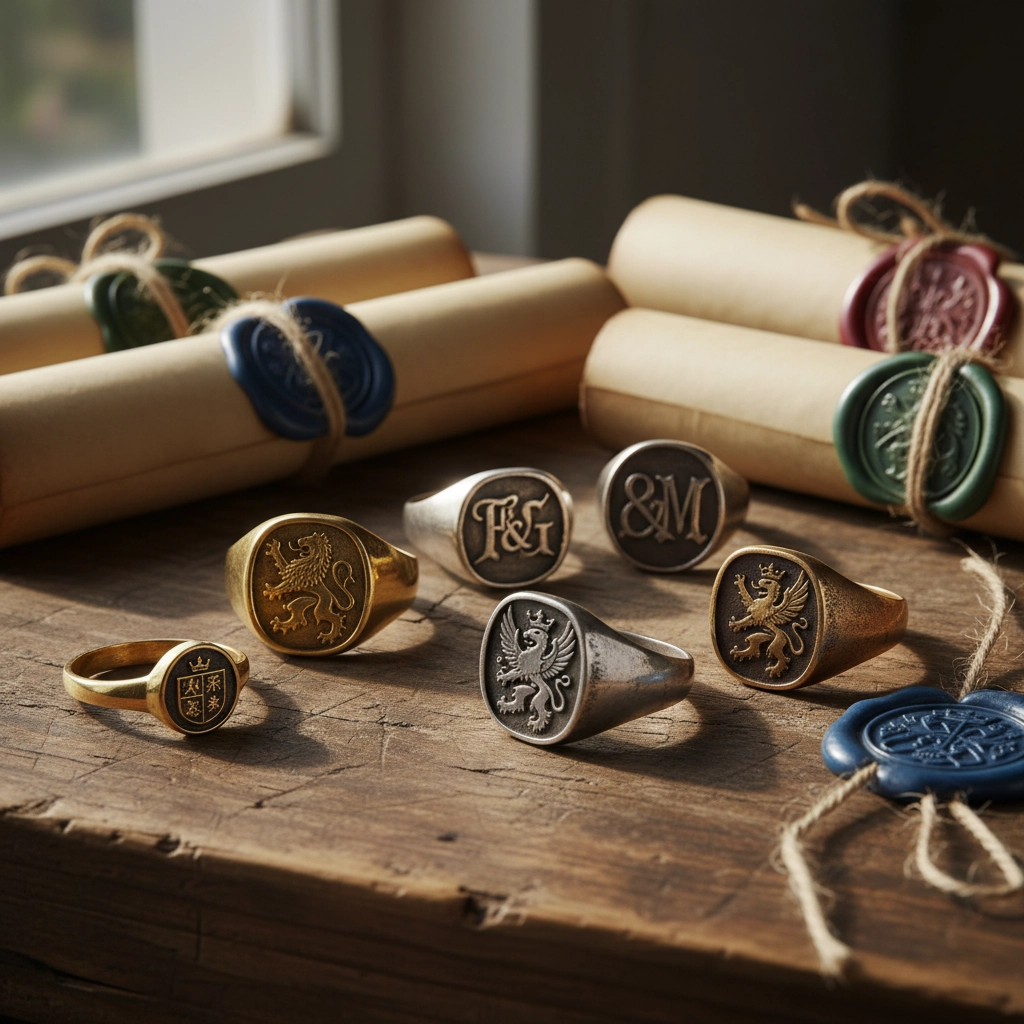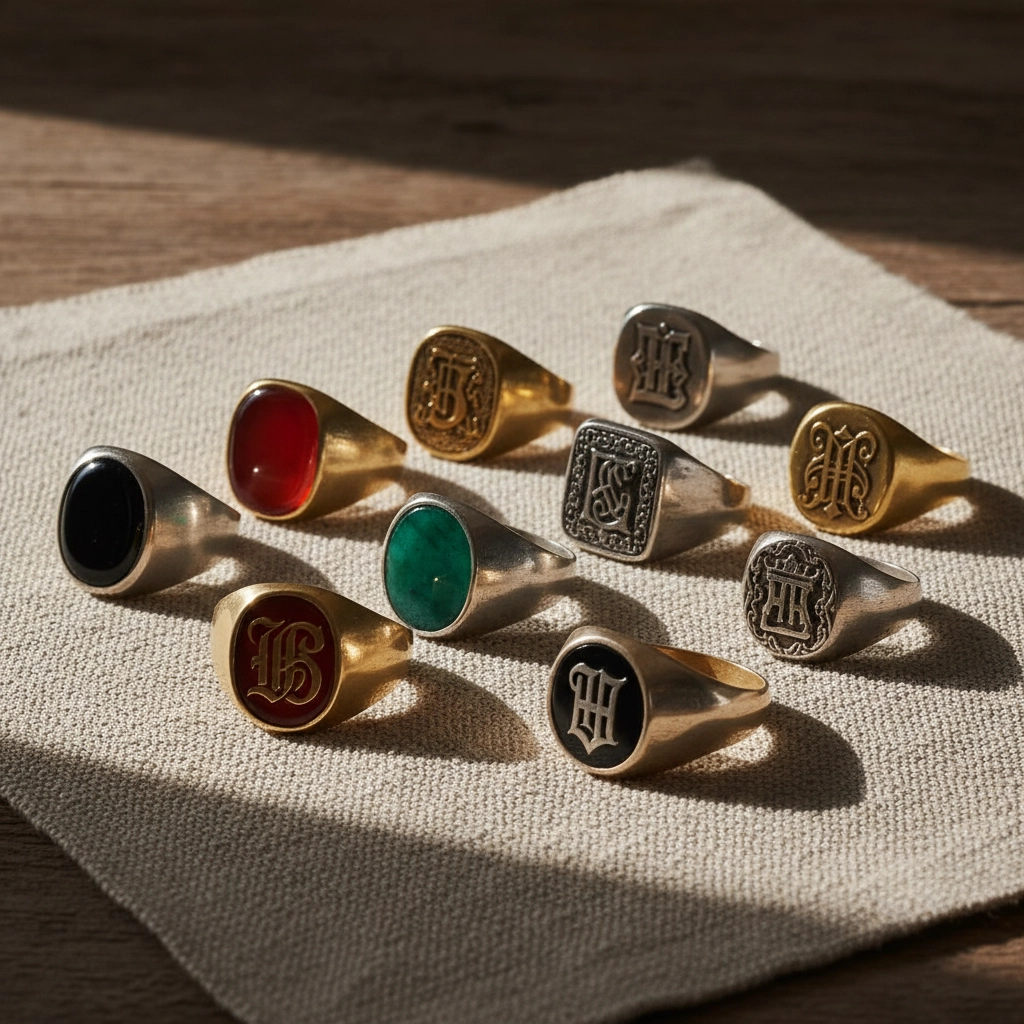Signature Saturdays: Signet Rings & Secret Codes : Power, Identity, and Hidden Histories
Welcome back to our Signature Saturdays where it's all about the jewelry itself.
Over the next several weeks, I'm taking you on a journey through some of jewelry history's iconic motifs. We're starting where power, identity, and secrecy first met metal: with signet rings.
Have you ever wondered why certain rings carry such weight? Why a simple band with an engraved surface can command respect in a room, or why families guard their signet rings like treasured heirlooms? The answer lies in over 5,000 years of hidden histories, secret codes, and the human need to leave our mark on the world.
The Birth of Wearable Authority
Picture ancient Mesopotamia around 3500 BCE. No smartphones, no digital signatures, no credit cards: just clay tablets, reed styluses, and the constant need to prove authenticity. This is where our story begins, with the world's first "security system" wrapped around someone's finger. [1]
Those early signet rings weren't just jewelry; they were the difference between a legitimate business deal and potential ruin. Imagine being a merchant whose livelihood depended on a small engraved cylinder that could be pressed into clay or wax. That tiny impression became your unbreakable promise, your legal signature, your very identity compressed into a few symbolic lines.
Egyptian pharaohs took this concept and ran with it, engraving sacred scarabs that connected their earthly authority to divine power. [2] But it was the Romans who really understood the psychology of signet rings: they knew that wearing your identity meant never having to explain who you were. [3]

The Minoan Masterpieces: When Rings Told Stories
If you think modern jewelry is detailed, you should see what the Minoans were creating between 1700 and 1000 BCE. These weren't just rings; they were miniature masterpieces featuring entire mythological scenes carved into gold bezels no bigger than your thumbnail.
I'm talking about rings depicting sitting goddesses, rows of figures bearing offerings, elaborate religious ceremonies: all compressed into a space smaller than a postage stamp. The craftsmanship was so extraordinary that archaeologists still study these pieces today, trying to decode the stories they tell. [4]
Here's what fascinates me most: these rings were loaded with hidden meanings. The mythological scenes weren't random decorations: they were carefully chosen symbols that communicated the wearer's religious beliefs, social status, and cultural affiliations. It was like wearing a secret code that only the initiated could fully understand.
The Unbreakable Seal: Security Through Symbolism
Think about the genius of signet rings for a moment. They were simultaneously the lock and the key, the signature and the pen, the secret and its protection. When you pressed that ring into wax or clay, you created something remarkable: an impression that would reveal any tampering attempts.
This security system was so effective that it became central to major historical events. Remember the biblical story of Daniel in the lions' den? King Darius didn't just seal that den with one ring: he used both his signet and those of his nobles, creating a symbolic barrier that represented the full authority of the state. Breaking such a seal wasn't just opening a door; it was an act of direct rebellion against royal power. [5]
I love this quote from a letter written by Lord Berengario in Verona in 906: "So that this may be more truly believed and more faithfully observed, we order this to be sealed with our ring, confirming it with our own hand." —Charter of Berengar I, Verona (906) [6]

Medieval Power Players and Secret Messages
Fast-forward to the Dark Ages, when signet rings evolved into sophisticated tools of political communication. I love this quote from a letter written by Lord Berengario in Verona in 906: "So that this may be more truly believed and more faithfully observed, we order this to be sealed with our ring, confirming it with our own hand." [6]
That wasn't just authentication: that was a command that demanded obedience. The seal carried the full weight of noble authority, and everyone understood its power.
But here's where it gets really interesting: women began claiming this power too. Byzantine Empire records show educated, powerful women wearing signet rings bearing family crests, asserting their authority as household managers and guardians of family legacies. Queen Aregunda's solid gold signet with her monogram, or the ring belonging to "Elena": these weren't just accessories. They were declarations of independence in societies that often overlooked women's authority. [7][8][9]
Cracking the Code: The Hidden Language of Signet Design
Every element of a signet ring spoke in code. The symbols, the materials, the craftsmanship: even which finger you wore it on: all communicated specific messages to those who knew how to read them.
Religious codes were everywhere. Many rings incorporated holy sigils and prayers for protection, hidden within seemingly decorative motifs. I've seen 6th-century silver rings featuring soldiers trampling dragons: likely belonging to military men, with the dragon representing conquered enemies or spiritual victory. [10]
Family crests weren't just pretty designs; they were genealogical records encoded in metal and stone. These symbols passed down through generations told stories of family history, alliances, achievements, and aspirations. Your ring didn't just say who you were: it told the story of everyone who came before you. [11]

Political messages were perhaps the most subtle. The choice of materials alone could signal loyalties and ambitions. A gold ring versus silver, a ruby versus an emerald, an elaborate crest versus simple initials: every choice was deliberate, every detail meaningful.
The Evolution: From Function to Fashion
As centuries rolled on, something fascinating happened. Signet rings began their transformation from purely functional tools into markers of social belonging. This shift reflected changing power structures: where once only rulers and wealthy merchants needed to authenticate documents, gradually more people acquired the wealth and status that signet rings represented.
The craftsmanship itself became a form of communication. Rings crafted from solid gold, platinum, or silver, often bearing hand-cut intaglios in stones like carnelian, onyx, or bloodstone, required significant investment in both materials and skilled artisanship. The choice of stone, the complexity of the engraving, the quality of the metalwork: all of it communicated the wearer's resources, taste, and social aspirations. [3]
Modern Mysteries: What Your Signet Ring Says About You
Today's signet rings carry forward this incredible tradition of visible authority and hidden meaning. Sure, we don't seal letters with wax anymore, but the psychological impact of wearing a family crest or personal symbol remains surprisingly potent.
Have you noticed how people react differently when they spot a signet ring? There's an immediate assumption of heritage, tradition, connection to something larger than oneself. Modern signet rings continue to serve as wearable legacy: tangible connections to family history, personal achievements, and social identity.

The "secret codes" might not be cryptographic in the modern sense, but they're still there. They exist in the sophisticated visual language that developed around power, identity, and belonging. Understanding signet rings requires decoding not just their obvious symbols, but the cultural contexts, material choices, and social conventions that give them meaning.
The Enduring Appeal of Wearable Identity
What draws us to signet rings today? I think it's the same thing that attracted ancient Mesopotamian merchants and medieval nobility: the desire to carry our identity with us, to have a tangible symbol of who we are and where we come from.
Whether it's a family crest passed down through generations, initials engraved in a contemporary style, or symbols that represent personal achievements or beliefs, signet rings let us wear our story on our hands. They're conversation starters, heritage preservers, and identity markers all rolled into one elegant package.
From ancient Mesopotamian merchants to Byzantine empresses to modern inheritors of family traditions, signet rings have maintained their unique position as jewelry that does more than adorn. They authenticate, communicate, and preserve the hidden histories of those bold enough to wear their identity on their hands.
Next Saturday, we're exploring another iconic motif that has captivated jewelry lovers for millennia: celestial symbols and their cosmic connections to human desire for beauty and meaning. Until then, take a look at the rings around you. What stories might they be telling? What codes might they be carrying forward from centuries past?
The secrets are there, waiting to be discovered.
Cheers,
Peter
---
References
[1] British Museum. Cylinder seals (collection overview). Accessed September 28, 2025.
[2] The Metropolitan Museum of Art. Scarabs and seals in ancient Egypt (Heilbrunn Timeline of Art History). Accessed September 28, 2025.
[3] Diana Scarisbrick. Rings: Jewelry of Power, Love, and Loyalty. Thames & Hudson, 2021.
[4] The Metropolitan Museum of Art. Gold Signet Ring (Minoan), 17th–15th century BCE (collection highlights). Accessed September 28, 2025.
[5] The Holy Bible, Daniel 6:17 (NRSV).
[6] Charter of Berengar I of Italy (Verona, 906). Monumenta Germaniae Historica (MGH), Diplomata Berengarii I.
[7] Brad Hostetler. Reading and Displaying Monograms on Byzantine Signet Rings. Journal of the Walters Art Museum 75 (2021).
[8] Musée d’Archéologie Nationale (Saint-Germain-en-Laye). Signet Ring of Queen Aregonde (Aregundis), 6th century. Accessed September 28, 2025.
[9] British Museum (via World History Encyclopedia). Byzantine Signet Ring inscribed “Manuel” (collection example). Accessed September 28, 2025.
[10] The Metropolitan Museum of Art. Byzantine Rings with Military Iconography (collection examples). Accessed September 28, 2025.
[11] Michel Pastoureau. Heraldry: Its Origins and Meaning. Thames & Hudson, 1997.